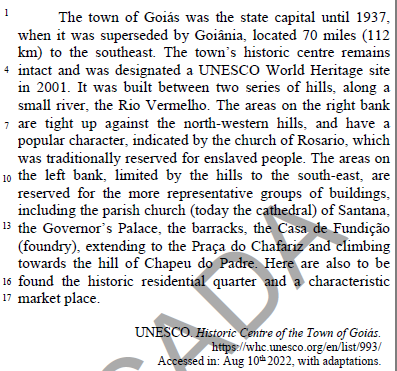In relation to the text, consider the following statements:
I. The text’s purpose is to instruct, guide or explain to the reader an important topic for the community.
II. It is a narrative and informative text, as it reports a fact and conveys information about a certain topic.
III. It is a narrative of the main life facts of a real person, made by another person.
IV. There is both verbal and non-verbal language in the text.
V. The text’s purpose is to promote a product, service, or activity.
The correct statements are found in:
In relation to the underlined letters of the word “happiness”, it is correct to say:
Which one of the following verbs is pronounced with a “d” sound at the end, in opposition to “t” and “id” sounds?
Looking back at text 5, say which one of the following items is correct.
Which one of the following verbs is pronounced with a “t” sound at the end, in opposition to “d” and “id” sounds?
After reading the text, choose which one of the following items is correct.
As far as semantics is concerned, choose which one of the following sentences contains an underlined word or expression that is used correctly.
Concerning the process of word formation, analyse the word unfortunately and decide which is the only correct following statement.
Choose which one of the following sentences can be correctly described as a feature of the audiolingual method.
Choose which one of the following sentence illustrates the case of apposition.
According to the author, explaining the brain as a computer is:
Here’s why we’ll never be able to build a brain in a computer
It’s easy to equate brains and computers – they’re both thinking machines, after all. But the comparison doesn’t really stand up to closer inspection, as Dr. Lisa Feldman Barrett reveals.
People often describe the brain as a computer, as if neurons are like hardware and the mind is software. But this metaphor is deeply flawed.
A computer is built from static parts, whereas your brain constantly rewires itself as you age and learn. A computer stores information in files that are retrieved exactly, but brains don’t store information in any literal sense. Your memory is a constant construction of electrical pulses and swirling chemicals, and the same remembrance can be reassembled in different ways at different times.
Brains also do something critical that computers today can’t. A computer can be trained with thousands of photographs to recognise a dandelion as a plant with green leaves and yellow petals. You, however, can look at a dandelion and understand that in different situations it belongs to different categories. A dandelion in your vegetable garden is a weed, but in a bouquet from your child it’s a delightful flower. A dandelion in a salad is food, but people also consume dandelions as herbal medicine.
In other words, your brain effortlessly categorises objects by their function, not just their physical form. Some scientists believe that this incredible ability of the brain, called ad hoc category construction, may be fundamental to the way brains work.
Also, unlike a computer, your brain isn’t a bunch of parts in an empty case. Your brain inhabits a body, a complex web of systems that include over 600 muscles in motion, internal organs, a heart that pumps 7,500 litres of blood per day, and dozens of hormones and other chemicals, all of which must be coordinated, continually, to digest food, excrete waste, provide energy and fight illness.[…]
If we want a computer that thinks, feels, sees or acts like us, it must regulate a body – or something like a body – with a complex collection of systems that it must keep in balance to continue operating, and with sensations to keep that regulation in check. Today’s computers don’t work this way, but perhaps some engineers can come up with something that’s enough like a body to provide this necessary ingredient.
For now, ‘brain as computer’ remains just a metaphor. Metaphors can be wonderful for explaining complex topics in simple terms, but they fail when people treat the metaphor as an explanation. Metaphors provide the illusion of knowledge.
(Adapted from https://www.sciencefocus.com/future-technology/can-we-build-brain-computer/ Published: 24th October, 2021, retrieved on February 9th, 2022)
The title of the text implies that the author will:
The ING form use in the sentence above the image follows the same pattern as in:
The pairs of words aim at oral practice which precisely targets the training of vowel pronunciation.
The criteria that accounts for the vowel distinction occurring in the chosen pairs are:
- Reach – Rich
- Seater – Sitter
- Eat – It
- Green – Grin
- Beat – Bit
- Feet – Fit





